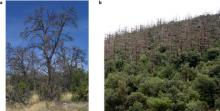Darcy's law predicts widespread forest mortality under climate warming

Drought and heat-induced tree mortality is accelerating in many forest biomes as a consequence of a warming climate, resulting in a threat to global forests unlike any in recorded history. Forests store the majority of terrestrial carbon, thus their loss may have significant and sustained impacts on the global carbon cycle. We use a hydraulic corollary to Darcy’s law, a core principle of vascular plant physiology, to predict characteristics of plants that will survive and die during drought under warmer future climates. Plants that are tall with isohydric stomatal regulation, low hydraulic conductance, and high leaf area are most likely to die from future drought stress. Thus, tall trees of old-growth forests are at the greatest risk of loss, which has ominous implications for terrestrial carbon storage. This application of Darcy’s law indicates today’s forests generally should be replaced by shorter and more xeric plants, owing to future warmer droughts and associated wildfires and pest attacks. The Darcy’s corollary also provides a simple, robust framework for informing forest management interventions needed to promote the survival of current forests. Given the robustness of Darcy’s law for predictions of vascular plant function, we conclude with high certainty that today’s forests are going to be subject to continued increases in mortality rates that will result in substantial reorganization of their structure and carbon storage.
McDowell, N. G., and C. D. Allen. 2015. Darcy’s law predicts widespread forest mortality under climate warming. Nature Climate Change advance online publication.
